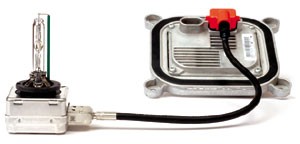The High Intensity Discharge (HID) bulb was first used in the production of new vehicles back in 1991. In the 25 years since its first installation, HID bulbs have developed and have been recognised as a sustainable, long lasting and reliable light source for forward lighting applications in many modern day vehicles.
HID bulbs use arc technology which produces an extremely bright arc of light from an electronically controlled gas discharge. This arc of light reduces energy consumption by a third to produce twice the light. The lifetime of HID bulbs far outlasts the lifetime of standard Halogen bulbs.
The high colour temperature, in some cases up to 5000 Kelvin, is almost the same colour temperature to that of daylight. With a wave of replacements now happening Osram has a solution for all needs and always recommends that bulbs should be replaced by trained technicians due to the high voltages involved in their fitment. This means there is an excellent opportunity for independent garages to stock such products and offer the service as an added revenue stream.
The use of HID bulbs often come with many questions, here Osram’s technical experts answers some of the most common ones:
Q. Why is the replacement HID bulb not as ‘blue’ and is slightly yellow compared with the other side?
A. It is a characteristic of HID bulbs that the colour changes through life. The colour shift is towards the bluer end of the spectrum. This means that if only one bulb is replaced, the new one will appear ‘yellower’ than the original. With use, the colour of the new one will shift as well and the difference will not be noticeable. The solution is to always change bulbs in pairs and the beam colours will then match.
Q: Can you tell us a little more about the Mercury free versions of the HID bulbs, developed by Osram?
A: Historically, all automotive HID bulbs contained a very small amount of Mercury. Recent developments have focused on reducing the environmental impact of lighting and the removal of all Mercury in automotive bulbs has been a priority. With the introduction of Osram D3 and D4 bulbs, this target has been achieved.
The design of the Mercury free bulbs however, requires them to operate under different electrical conditions, so they cannot be run on the normal HID ballasts.
Vehicles have to be designed for the Mercury free products and different keying on the connectors prevents the wrong bulb being used.
 Q: I have changed an HID bulb, but the new one doesn’t work?
Q: I have changed an HID bulb, but the new one doesn’t work?
A: HID bulbs have a very long operational life but they do occasionally fail to light. However this is often not due to a bulb failure as the ballast can malfunction or the supply to the ballast can fail.
Poor mating of the connecting cable has also been seen in the past and this can cause the pins to be bent or damaged.
Q: Are the kits that convert halogen lights to HID legal?
A: HID bulbs produce about twice the light of a halogen bulb so the headlights have to be specially designed to prevent glare to on-coming drivers. To control glare, cars fitted with HID must, by law, also be fitted with headlight cleaning and automatic headlight levelling. These features are not fitted to vehicles normally, so retro-fitting HID bulbs can generate considerable glare.
HID systems use very high voltages so if you use one of these conversion kits it can present a serious risk. With ever more complex electronics on modern vehicles, interference from these retro-fit systems can cause electrical malfunctions. Consequently, fitting these systems will almost certainly make the vehicle illegal for road use with all of the implications for insurance etc.
Q: How can I be sure I have bought Genuine OSRAM HID (Xenon) bulbs?
A: Osram always aims to supply the highest quality products. We therefore monitor all quality and performance aspects of our products throughout the whole manufacturing and shipping process as carefully as possible. In recent years, we have seen a rising number of products which try to copy not only certain parts of our products but also our name, our logo and our packaging. This has resulted in a lack of certainty regarding the originality of our products. To combat the fakes and to help consumers verify the products they buy Osram have developed the Osram Trust Program.
The Osram Trust Program enables customers to confirm the originality of the HID bulbs they purchase by checking two features that are added to HID bulbs during the manufacturing process. These features enable the bulbs purchased to be authenticated quickly and easily by checking them on our online tool.











